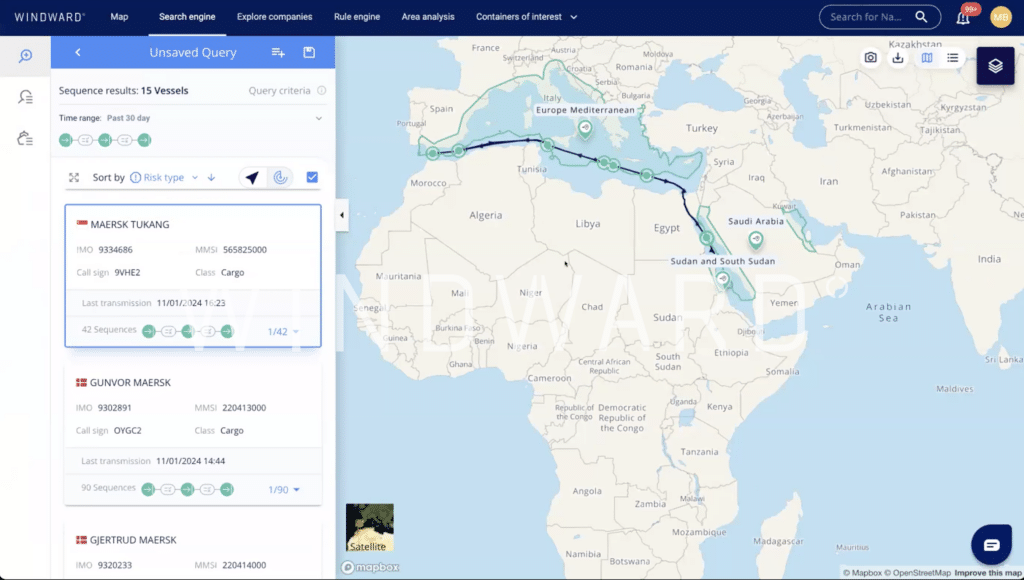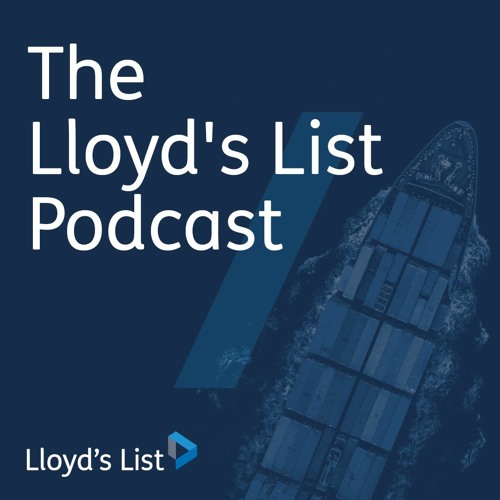- Maritime Data Newsletter
- Posts
- Red Sea Special 🚨 Tracking the volatile security situation 🛰️ US slaps sanctions on half a dozen ships 🇺🇸 and more
Red Sea Special 🚨 Tracking the volatile security situation 🛰️ US slaps sanctions on half a dozen ships 🇺🇸 and more
Maritimedata.ai is a digital broker that provides data and analytics solutions for the maritime ecosystem.
Source, evaluate and purchase maritime data and analytics from the largest network of specialised providers in the world.
The newsletter provides you with up-to-date information on the most recent advancements in space and market insights produced by partners in the Maritime Data network.
Insights 📈
Since the beginning of December, continuous rain has been affecting Australia's coal exports (link) & (link)
Dry Bulk spot freight rates have remained under pressure amid rising tonnage supply (link)
How will the current situation in Libya affect the tanker market? (link)
Dry Cargo Forecast - China steel demand to decline by 3.3% (link)
2023 review - Commodities Changing Patterns and Freight Market (link)
Red Sea 🌊
The Red Sea Crisis: Tracking the volatile security situation Spire
Red Sea Attack Challenges: Port Congestion Updates Portcast
US slaps sanctions on half a dozen ships and companies owing to Houthi and Iran links & Red Sea Risk explained Lloyd’s List
The Red Sea and The Houthis Geollect
Q&A: Understanding the Impact of the Red Sea Crisis Windward
Red Sea attacks and Panama Canal drought lead to gas carrier rerouting Vortexa
Coming soon…
2024 Prediction Series
We ask Leaders and Experts from the leading Maritime Intelligence Companies in the world what their predictions are for 2024.
Make sure you follow the Maritime Data Linkedin Page for updates.
The Red Sea Crisis: Tracking the volatile security situation Spire
Commercial vessels seeking protection
Some vessels still sailing through the Red Sea changed their destination in the AIS data destination field to ‘VL NO CONTACT ISRAEL’ in the hope that they would be able to sail safely through the area and protect themselves from Houthi attacks.

Another observation from the AIS data destination field are the mentions of ‘ARMED GUARDS ON BOARD’, the use of which increased significantly towards the end of 2023 compared to the same time in the previous year. These mentions are aimed to discourage potential hijackers.
The below graph including Historical AIS data shows that over the course of 2023 maritime traffic in the Red Sea, the Gulf of Aden, and the Gulf of Suez has been considerably higher than in the previous year. Upon the Red Sea attacks starting however, a decline in traffic is noticeable. A further sharp decline in traffic is showing from the 16th of December resulting in 2022 traffic surpassing 2023 traffic in a year-on-year comparison by the 23rd of December.

Light blue line – traffic in 2022 (Red Sea, Gulf of Aden, Gulf of Suez)
Dark blue line – traffic in 2023 (Red Sea, Gulf of Aden, Gulf of Suez)
Red Sea Attack Challenges Portcast
Increase in Port Activities Across African Ports Amid Red Sea Attacks
Portcast have analysed all African ports, contrasting the visit counts from the past week with the average weekly figures over the last three months. They specifically looked for ports that exhibited an uptick in visits and congestion compared to their performance throughout the year. Ultimately, they identified the three ports.
The graphs presented indicate congestion levels have not been observed at such heights since November 2022. This recent surge in port activity appears to align with the diversions occurring in the Red Sea.
Here are insights into three key ports that have witnessed substantial changes:
1. Mtwara Port, Tanzania (TZMYW):

In December, the vessel count at Mtwara port surged from an average of 1-2 vessels per week to 6-7 vessels per week.
The median congestion, measured in hours, exhibited a remarkable escalation from the three-month average of 3 hours to well over 10 days in December.
2. Mombasa Port, Kenya (KEMBA):Book a call

Over the past three months, Mombasa port has maintained an average vessel count of approximately 15 vessels per week.
However, the most recent week saw a substantial uptick, with as many as 23 vessels visiting the port. This influx contributed to a considerable rise in median congestion, elevating from the three-month average of 28 hours to around 100 hours.
3. Pointe Noire Port, Congo (CGPNR):

Pointe Noire Port observed an increase in vessel count, rising from the three-month average of 15 to 20 vessels in the last week.
The median waiting time, measured in hours, surged from the three-month average of 50 hours to approximately 90 hours.
US slaps sanctions on half a dozen ships and companies owing to Houthi and Iran links Lloyd’s List
The US has slapped sanctions on four tankers and two companies for shipping Iranian commodities on behalf of a Houthi ‘financial facilitator’ backed by the Islamic Revolutionary Guard Corps-Quds Force. It is the first targeting of Iran-linked vessels by Ofac since March.
Ofac said the two blacklisted companies, UAE-based Global Tech Marine Services and Hong Kong-based Cielo Maritime, shipped commodities on behalf of a Houthi facilitator, Sa’id al-Jamal, himself sanctioned in 2021.
Cielo owns and manages the 1999 built, Panama-flagged suezmax Mehle (IMO: 9191711), Ofac said.
Global Tech manages and operates the 1999-built, Panama-flagged long range one product tanker Sincere 02 (IMO: 9226011), and operates the 2003-built, Panama-flagged aframax Fortune Galaxy (IMO: 9257010); and Cameroon-flagged panamax Molecule (IMO: 9209300), Ofac said.
Lloyd’s List Podcast: Red Sea Risks Explained
As the missiles fly and ships divert, the Lloyd’s List team are joined by industry experts to offer expert views on how the events in the Red Sea are going to be shaping shipping markets and risk assessments globally over the coming days and weeks
The Red Sea and The Houthis Geollect
Since the outbreak of conflict in Israel and Gaza, commercial shipping travelling through the Red Sea and the Bab al-Mandab Strait has come under attack from the Houthi group, a relatively sophisticated non-state actor operating in Yemen with heavy links to Iran. The Houthis have often claimed that these targets are linked to Israel, Israeli companies and/or Israeli individuals, and are targeting them in response to Israel's ongoing campaign against Hamas in Gaza. However, as the frequency of attacks has increased over the past few weeks, the attacks have evidently become less discriminate in their nature, suggesting that the Houthi's intent is to make the Bab al-Mandab strait unpassable for international trade.
In order to prevent this, a US-led coalition of western naval powers - including the UK - has launched Operation Prosperity Guardian, in order to protect the freedom of navigation of commercial vessels through the area. In response to direct attacks against these warships on the 10th January, both the US and the UK have begun limited and proportionate strikes against Houthi targets in Yemen in order to deter further aggression.
Re-routing via the Gulf of Guinea - one threat for another?
Not only does re-routing critical maritime traffic significantly increase the time and cost of trade and transit, it also exposes vessels to other security threats, which may simply trade one risk for another. Any shipping heading on a course from the Cape of Good Hope toward the Mediterranean or North Sea will likely pass through the Gulf of Guinea, a littoral area which has persistently seen the highest levels of maritime piracy in the world since the decline of the the threat of Somalian piracy in the late 2000s/early 2010s. The below Storymap created by Geollect earlier this year summarises why maritime insecurity in the Gulf of Guinea will persist and remain a critical security threat to both the region and global trade for the foreseeable future.
Q&A: Understanding the Impact of the Red Sea Crisis Windward
Windward’s recent webinar on the Red Sea crisis was their most popular one yet. Host Ami Daniel, Windward’s Co-Founder and CEO, kept it interactive and made sure that the top industry experts who were participating shared their actionable insights and answered as many of the questions that popped up as possible. Those experts included:
Peter Sand, Chief Analyst, Xeneta
Joshua Hutchinson, Managing Director Intelligence & Risk, Ambrey
Jakob P. Larsen, Head of Maritime Security and Safety, BIMCO
Dark Activities by Container Vessels
Question: Is it safer to turn off a vessel’s AIS to avoid Houthi attacks?
Joshua Hutchinson from Ambrey noted that some vessels that turned their AIS off early on in the conflict were still targeted. There are several ways to track a vessel that are still publicly available. Turning off the AIS doesn’t mean a vessel is completely hidden. We’ve also seen an escalation in the past couple of weeks where we see spotters on the water. UAVs are being used to recon targets before impact, that has been well-recorded in the area.”
What is BIMCO’s recommendation? Jakob P. Larsen explained that the decision depends on each company and their risk assessment. The reality is that BIMCO can’t and won’t give specific recommendations, but rather outlines what is going on and how these factors interact, and then each organization can make its own decision, depending on its risk appetite.How we can help

Vessel Movement Patterns and the Suez Canal
Question: Do you notice a pattern of vessels crossing the Suez Canal and turning back to Europe?
The Windward Maritime AI™ platform’s new Sequence Search capability enables users to track vessels’ sequence of activities. During the webinar, Mattan Benyamini, Product Manager at Windward, used this new technology to report that 15 large cargo container vessels had visited the Mediterranean Sea, passed through the Suez Canal, and then returned to Europe within the last month. This pattern underlines the significant impact of the crisis on the global supply chain. During this ongoing crisis, technology can be and should be used to stay on top of changes.


15 large cargo container vessels that had visited the Mediterranean Sea, passed through the Suez Canal, and then returned to Europe within the last month. Screenshot taken from Windward’s Maritime AI™ platform.
Red Sea attacks and Panama Canal drought lead to gas carrier rerouting Vortexa
When faced with the two-pronged issue of Panama Canal transit difficulty plus the possibility of attacks in the Red Sea, gas carrier operators are driven to make altering navigational decisions, and the Cape of Good Hope (COGH) is proving a viable route. Since the attacks on non-Israeli vessels transiting the Red Sea began in mid-December, we are tracking 32 gas carriers (LPG and LNG carriers) transiting West of Suez-to-East of Suez via the Cape of Good Hope. 26 of these vessels are likely following this trajectory due to ongoing Panama Canal transit issues instead of geopolitical developments unfolding in the Middle East.
Panama Canal transits for LPG carriers remain low, though laden transits numbers are recovering slightly so far in January. Both alternate waypoints – COGH and Suez – have a similar duration for most East of Suez destinations for North American-origin voyages, so some operators may prefer the COGH to avoid Suez Canal costs. Similar numbers of LNG carriers are transiting via COGH. This behaviour is also occurring on the ballast leg from EoS-to-WoS, especially as Northbound transit numbers for ballast LPG carriers via the Panama Canal have remained under pressure, hovering around just 1 vessel per day.

How we can help
Select the data you’re interested in and we’ll generate a shortlist of options
Explore which of our 200+ data and analytics solutions can support you
Start receiving enquiries and meeting new clients
You might be receiving this email because we believe that the content of our newsletter may be of interest to you based on your profession. However, if we have made an incorrect assumption, we apologize for any inconvenience caused. If you do not wish to receive future publications, please follow the instructions below to unsubscribe.
Thank you for your time.
Best regards,
Rory Proud
Co-Founder
